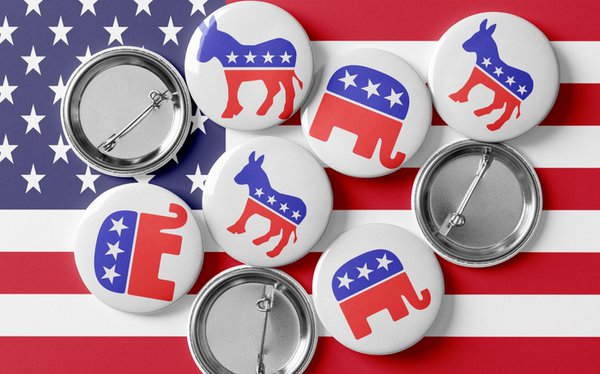
The seven ‘swing states’ are all-important for Republicans and Democrats
“This archaic system is not based on the popular vote but on an electoral college. When an American citizen votes on the Tuesday following the first Monday of November (this year, November 5), he/she is not voting for the candidate but a slate of electors. Though there is no constitutional compulsion, these electors pledge to vote for one of the candidates when the 538-strong electoral college meets on the first Tuesday after the second Wednesday in December, (this year, December 17). A simple majority of 270 or more electoral votes is needed to win the election. In 2020, Biden won 306 electors against Trump’s 232, and he also got 7 million more votes than Trump.”

Amid the election season in the US, it is important to understand that the American electoral system is ossified — the results in certain states are a foregone conclusion and thus they are clearly identified as red (Republican) and blue (Democratic) states. The 2024 presidential election will really depend on the outcome in just seven of the 50 states and about 100,000-200,000 voters.
An analysis of Super Tuesday primaries, along with US census data, tells us that Trump has wide Republican support, but it varies demographically. This archaic system is not based on the popular vote but on an electoral college. When an American citizen votes on the Tuesday following the first Monday of November (this year, November 5), he/she is not voting for the candidate but a slate of electors. Though there is no constitutional compulsion, these electors pledge to vote for one of the candidates when the 538-strong electoral college meets on the first Tuesday after the second Wednesday in December, (this year, December 17). A simple majority of 270 or more electoral votes is needed to win the election. In 2020, Biden won 306 electors against Trump’s 232, and he also got 7 million more votes than Trump.
Sparsely populated Wyoming, North and South Dakota have three electoral votes each; California has 54 and Texas 40. As per predictions, California will go blue and Texas red. States can and do flip between blue and red, but no one is expecting that this time around.
The seven ‘swing states’, where the election will be decided, are Arizona (11 electoral votes), Georgia (16), Michigan (15), Nevada (6), Pennsylvania (19), Wisconsin (10) and North Carolina (16). In 2020, Joe Biden won all of them except North Carolina. Currently, Donald Trump is leading in five of these states and Biden desperately needs to retain Michigan, a state with a significant number of Arab-Americans who are angry with his West Asia policy.
An analysis of the Super Tuesday primaries, along with US census data, tells us that Trump has wide Republican support, but it varies demographically. He has done better in counties with lower levels of college education and lower incomes. His support is strong in rural counties, but not in large metro areas. Also, support is in places with population older than 50; he is less popular with younger voters, who had favored Biden overwhelmingly in 2020. There is also a gap between those who voted for Haley in the primaries — who tended to be college-educated and against a federal abortion ban and not too happy with Trump’s personality.
If the Democratic Party is able to convert some of the energy Biden displayed in his State of Union (SOTU) address last Thursday into its campaign hereafter, it will go some way in blunting doubts about his age (81). What is clear, though, is that Biden retains that “fire in the belly” that has made him a successful politician.
However as of now, the opinion polls have been saying something else. A New York Times-Siena poll at the beginning of this month said if the elections were held today, 48 per cent would vote for Trump and 43 per cent for Biden. The President’s problems have been accumulating — doubts about his fitness, the backlash over US support to Israel, fears over immigration on the southern border and the continuing worries over the impact of inflation. Even as Trump has consolidated his hold over the Republican Party, Biden’s Democrats are splintering. He is having trouble in retaining the support of younger voters as well as non-college-educated Blacks and Hispanics.
And then there are third-party candidates. In the US system, it is not easy for such candidates to get onto the ballot, but this time there are three — the well-funded Robert F Kennedy Jr, Jill Stein of the Green Party and Cornel West, the leftist political activist. There is also a threat from No Labels, a political organization, to come up with a candidate who will target Republican and Democratic votes. They have no chance of winning, but by depriving a candidate of 5-10 per cent of the vote, they can alter the verdict in particular states, skewing the larger result. As of now, their impact is falling heavier on Biden than Trump.
Eight months are a long time in the presidential elections, and the opinion polls are not always accurate. Issues will be rejigged and new ones can surface. The rate of inflation is declining and people’s skeptical assessment of the economy could change. A ceasefire in West Asia and even Ukraine could shift views, and a Trump conviction in any of his cases could change perceptions of some swing voters.
A Biden victory would have largely predictable consequences, but what will a Trump win bring? There has been an old-fashioned consistency and achievement in Biden’s policies. He has restored the American alliance system and revitalized the US economy, even while maintaining a tough line on China and Russia. He has indicated that the US remains part of the global system by supporting policies to fight climate change and re-engaging with the WHO.
With Trump, it’s different. He is now in complete control of the Republican Party and is, in a sense, ‘unchained’. At the best of times, he is unpredictable and inconsistent. This time, he is going in with a plan to pack the entire government and the judiciary with his supporters and negate all checks and balances on presidential powers. He could walk out of NATO, abandon Ukraine and give up on free trade. The only comfort is that while his approach to India will be transactional, it will not be hostile and could even be friendly.
(The author is a Distinguished Fellow, Observer Research Foundation, New Delhi)





Be the first to comment